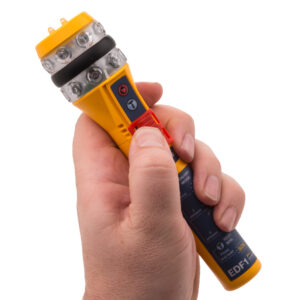
- Blog
-
by Pete Green
When it comes to safety equipment for yachts, flares are an essential item for any vessel. Traditionally, pyrotechnic flares have been the go-to option for signaling distress at sea. However, in recent years, electronic safety flares have become increasingly popular.

Pros and Cons of moving from pyrotechnic flares to electronic flares.
Pros of Electronic Safety Flares:

• Reusability: One of the most significant advantages of electronic safety flares is that they are reusable. Unlike pyrotechnic flares, which can only be used once whereas electronic flares can be used multiple times, making them a more environmentally-friendly option.
• Disposal of Pyrotechnic flares: There are very few ways of legally disposing of either used our out-of-date pyrotechnic flares: They can end up often residing is lockers, garages or sheds well past their expiry date.
• No fire hazard: Electronic flares do not pose a fire hazard, unlike pyrotechnic flares, which can be dangerous if not handled properly. This makes electronic flares a safer option for both crew and vessel.
• Longer lifespan: Electronic flares have a longer lifespan than pyrotechnic flares. They can last for years with proper care, while pyrotechnic flares typically have a shelf life of only a few years.
• Visibility: Electronic flares can be visible from miles away, even in daylight conditions. They emit a bright, flashing light that is easily recognizable as a distress signal.
Cons of Electronic Safety Flares:

• Cost: Electronic flares can be more expensive than pyrotechnic flares, which can be a significant factor for some yacht owners.
• Battery life: Electronic flares require batteries, and the battery life can be a concern, especially if the flares are not used regularly. It’s important to check and replace the batteries regularly to ensure that the flares are always ready for use.
• Limited range: Electronic flares have a limited range compared to pyrotechnic flares. They are typically visible from a few miles away, while pyrotechnic flares can be seen from up to 25 miles away.
• Not universally recognised: Electronic flares are not universally recognised as a distress signal, which means that some rescue services may not know what they are or how to respond to them.
• Not all types of flare are available in an electronic version: Parachute, Anti-Collision and Orange Smoke Marking flares are generally only available in a pyrotechnic version.
Be Aware:
Current regulations make it mandatory for certain recreational craft to carry flares for distress alerting: Class XII vessels (i.e. pleasure vessels of 13.7 metres (45ft) in length and over) to carry four red hand-held pyrotechnic flares.
For more info from the MCA: MCA – Flares
Conclusion:
Electronic safety flares have many advantages over pyrotechnic flares, including reusability, safety, longer lifespan, disposability, and visibility. However, they do have some drawbacks, including cost, battery life, limited range, and not being universally recognised. It’s up to each yacht owner to weigh the pros and cons and decide which option is best for their vessel and crew. Regardless of the type of flares used, it’s essential to ensure that they are always in good working order and ready for use in case of an emergency.

With highly qualified and experienced crew, Halcyon Yachts Ltd offers a dedicated international yacht delivery service. For more information or to see details of their recent deliveries please visit:




Tamir Neeman
One big Pro of Ocean Signal rescueME Electronic Distress Flare EDF1
I stored one unit inside my Spinlock lifejacket attached by a string